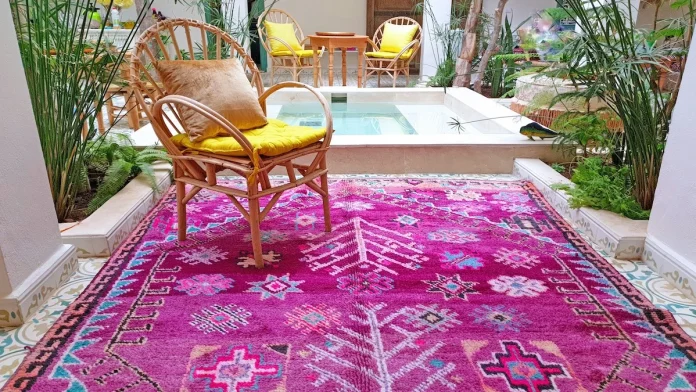Moroccan Berber rugs, known for their rich history and cultural significance, are more than just floor coverings; they’re woven representations of the Berber, or Amazigh, people’s heritage in North Africa’s Atlas Mountains. These rugs, renowned for their unique patterns, colors, and craftsmanship, encapsulate the Berber community’s traditions and beliefs, passed down through generations. Today, these timeless pieces have garnered global appreciation for their aesthetic appeal and their role in preserving a deep cultural legacy.
Origins and Craftsmanship: Weaving Culture and Nature Together
Berber rug-making originated out of necessity for warmth and durability in the harsh climate of Morocco’s Atlas Mountains. Using locally sourced wool and plant-based dyes, Berber artisans developed a distinctive weaving style characterized by intricate symbols and patterns, each holding deep cultural meanings. The rugs, often handwoven by Berber women, use symbols like diamonds for protection and triangles for femininity, while zigzags and cross motifs reflect landscapes, family bonds, and life’s journeys.
Regional Styles: Distinctive Art Across Moroccan Berber Tribes
Moroccan Berber rugs vary significantly between regions, with each tribe producing a unique style:
Beni Ourain rugs from the Middle Atlas Mountains feature minimalist black-and-white diamond patterns, embodying themes of protection.
Azilal rugs from the Azilal province are vibrant and asymmetrical, often reflecting the weaver’s emotions and creativity.
Boujad rugs near Marrakech use warm hues like pink and red, symbolizing love and femininity, and are cherished for their intricate designs.
A Growing Global Appreciation
As demand for Moroccan Berber rugs rises internationally, these rugs are celebrated for their craftsmanship, cultural richness, and authenticity. Many consumers are drawn to the historical depth and symbolism woven into each piece, a rarity in today’s mass-produced market. By purchasing authentic Berber rugs, buyers are directly supporting the Berber artisans, helping sustain these communities and their artistic heritage.
Preserving Berber Tradition in a Modern World
With the global spotlight on Berber rugs, there is a growing movement within Berber communities to maintain the authenticity of their craft while adapting to modern tastes. Younger artisans are embracing innovative designs and techniques, bridging tradition with contemporary art forms, and ensuring that Berber rug-making remains vibrant and relevant.
For those who acquire these pieces, understanding the cultural context adds to their appreciation, as each rug carries a legacy of resilience, beauty, and a deep connection to the Berber people’s land and traditions.
Caring for Your Berber Rug
To preserve the beauty and integrity of Berber rugs, owners are encouraged to follow proper care practices, such as light vacuuming, gentle spot cleaning, and professional maintenance when needed. With thoughtful care, these rugs can endure for generations, keeping their symbolic meanings intact.
Moroccan Berber rugs remain cultural artifacts that connect modern buyers to a rich and storied past. Through their purchase and preservation, these pieces continue to tell the stories of the Berber people, bridging worlds and generations with every knot and symbol.




